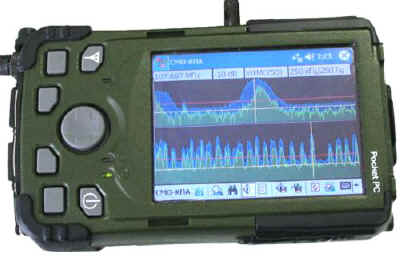
The US, Israeli, and Indian armies are arming their soldiers with industrial-grade pocket computers (PDAs) that can be used in the field.
Industrial rugged PDAs can operate in high humidity, rain, sandstorms, high and low pressure, low and high temperatures, and must be resistant to acoustic noise.
The main application of industrial PDAs [1] in the field today is navigation-related tasks.
When equipped with a GPS receiver and data transmission devices, an industrial PDA becomes a powerful tool that helps navigate the terrain while performing a task.
The PDA screen can display the current location of the mobile group, the destination point, and the preferred route.
If necessary, similar data related to the work of other groups involved in the task can be displayed there, which improves the quality of interaction between units and makes management more flexible.
The electronic map of the area can display various objects, including data on minefields, probable enemy locations, etc. Of particular interest is that all of this information can change dynamically.
Industrial PDAs can also serve as individual means of collecting various information, which, if there are appropriate means of communication, can be transmitted to a remote central post for subsequent processing.
Finally, industrial PDAs can be used to control various special equipment, which allows them to be used to create hardware and software systems designed to solve special problems in the field.
It is precisely this application of industrial PDAs that will be discussed in more detail below.
Industrial PDAs are manufactured in various countries around the world. They are also manufactured in Russia.
The domestically developed industrial PDA «Kulon» has a number of significant advantages over its foreign counterparts.
The ultra-small dimensions (90x150x33 mm) and weight (450 g) of the device provide a high level of mobility and availability of computing resources.
The pocket computer can be transported on the equipment (in a special pocket or attached to a belt).
The VGA screen resolution (640×480, 256 colors) allows displaying a larger volume of information compared to other pocket computers. This provides additional advantages when using the device for navigation, working with spreadsheets and the Internet.
The presence of a PCMCIA slot, a full-fledged serial port (the RS-232 port is connected to an external DB-9 connector on the product case) and USB 1.1 Host (an external USB-A connector on the product case) makes it possible to connect a wide range of peripheral equipment (external storage devices, DAC/ADC, etc.) equipped with drivers for the corresponding operating systems.
The Kulon PDA is equipped with a standard high-capacity 1800 mAh battery, providing up to 13 hours of autonomous operation (depending on the backlight brightness and resource intensity of applications). Typically, devices of this class are equipped with 900 — 1300 mAh batteries.
The front panel of the Kulon PDA has a wireless interface on/off key for ease of use and battery saving (extending the autonomous operation period).
The Kulon PDA body is cast from aluminum-magnesium alloy, which ensures high resistance to external mechanical impacts, such as vibrations and impacts. All connectors of the product are protected by rubber plugs to ensure their protection from moisture and dust.
Information input and control are carried out mainly using the touch screen and four function keys, which can be programmed to call up individual databases, software tools, etc. It is possible to connect an external industrial USB keyboard. The product is equipped with a docking station for communication with any computer equipped with a USB 1.1 bus.
The Kulon PDA can be supplied with a pre-installed Microsoft Windows Mobile 2003 operating system, which allows using a huge number of applications compatible with the following operating systems: РРС 2000, РРС 2002, WM 2003.
Table 1 shows the specifications of the Kulon PDA. Table 2 shows the data on the resistance of the Kulon PDA to external factors in the operating mode.
Table 1. Specification of the Kulon PDA
| Operating system | Microsoft® Windows Mobile 2003 |
| Processor | Intel XScale PXA255, 400 MHz |
| RAM | 128 MB (SDRAM) |
| ROM | 64 MB (NAND flash) |
| Display | 4″ TFT LCD, 480×640, 256 colors; or 240×320, 64K colors |
| User input | touch screen, stylus |
| Sound | built-in mono speaker, built-in microphone |
| External ports | USB x 2 (host x 1 USB 1.1 standard connector, client x 1 mini connector); serial port x 1 (DB9 RS232, COM1); PCMCIA x 1 (type II, Compact flash slot accessible using PCMCIA-to-CF adapter SD x 1 (for memory cards only); external microphone/headphone connector (jack) x 1; power connector x 1; docking station connector x 1 |
| Main battery | Lithium-Ion, 7.4 V, 1800 mAh |
| Built-in backup battery | NiMH, 3.6 V, 20 mAh |
| Case | magnesium-aluminum alloy |
| Dimensions | 90x150x33 mm |
| Weight | 450 g, including battery (110 g) |
Table 2. Resistance of the Kulon PDA to external factors in operating mode
|
Test name |
Methodology |
| Resistance to sinusoidal vibration | acceleration 6 g; oscillation frequency 5 … 500 Hz; test duration 1 h |
| Resistance to random vibration | frequency 5 … 1000 Hz; acceleration spectral density 0.001 … 0.01 g2/Hz; test duration 2 h |
| Resistance to single impact | Impact load 120 g; duration of impact 5 ms; number of impacts 18 (3 impacts in 6 directions) |
| Resistance to repeated mechanical impacts | Shock load 15 g; duration of impact 15 ms; number of impacts 10,000 |
| Resistance to linear acceleration | Acceleration 15 g; duration of impact 3 min (in each of 6 directions) |
| Resistance to low temperatures | Temperature -20° C; test duration 4 hours |
| Resistance to high temperatures | temperature range +23 … +55° C; cycle 12 hours at +23° C, 12 hours at +55° C (total 24 hours); number of cycles 3 |
| Resistance to atmospheric condensed precipitation (frost and dew) | temperature difference -20 … +20° C; cycle 2 hours at -20° C when switched off, 3 hours at +20° C (humidity 60%, pressure 764 mm Hg); test duration 5 hours |
| Resistance to low pressure in operating mode | minimum pressure 140 mm Hg (maximum altitude 12 km); test duration 1 hour |
| Resistance to high atmospheric pressure | pressure 1140 mm Hg; tests were carried out both in working and non-working states |
| Resistance to high air humidity | 16 hours at a temperature of +55° C and humidity of 93%; 8 hours at a temperature of +50° C and humidity of 100%; cycle duration 24 hours; number of cycles 10 |
| Resistance to rain | precipitation rate 5 mm/min; droplet incidence angle 45°; droplet size 0.5 … 4.5 mm; test duration 2 h |
| Resistance to solar radiation | heat flux density 1120 W/m2; temperature +20° C; pressure 101.3 kPa; test duration 120 h |
| Resistance to static dust | dust concentration 2 g/m3; flow speed 1 m/s; test duration 2 h + 2 h (air flow for 2 h, then dust settling for 2 h) |
PDAs generally have worse characteristics compared to their «older» counterparts, laptops and tablet computers. They have a weaker processor and less memory. The main advantages are low weight, power consumption and compact size.
Therefore, the use of these devices to control specialized equipment is justified if the specialized equipment itself is so compact that it can be moved by one person, and also be used for work when the operator is moving.
Otherwise, it is more appropriate to use industrial laptops or tablet computers.

Photo 1. Protected PDA «Kulon»
Thus, it makes sense to use protected PDAs to control the so-called portable devices.
The ARK-RP3 hand-held direction finder (photo 2) and the ARK-NK3I portable radio monitoring and direction finding measuring complex belong to this class of devices.
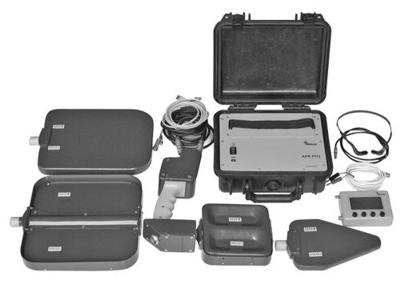
Photo 2. ARK-RP3 hand-held direction finder
The ARK-RP3 hand-held direction finder is designed to determine the location of radio emission sources on the ground. It is based on the digital radio receiver «ARGAMAK» (ARK-PR5) [2] and has all the main characteristics (Table 3) provided by this device.
These characteristics include, in particular, small dimensions and light weight, which makes it very effective for use as a means of detecting the location of radio transmitters for small mobile groups moving on foot [3].
The «ARGAMAK» receiver included in the direction finder is mounted in a waterproof, shockproof case-type housing (IP65 protection rating) and is equipped with a replaceable set of batteries that provide continuous operation for at least 6 hours.
The product is designed to operate in a temperature range from -20 to +55° C.
Direction finding is carried out by the amplitude method using a set of directional antenna modules designed for a frequency range from 300 kHz to 3 GHz.
The entire working set can be stored in a backpack behind the operator.
Table 3. Main technical characteristics of the ARK-RP3 hand-held direction finder
| Range of operating frequencies in reception mode | 0.3 … 3000 MHz |
| Receiver input sensitivity, not worse | 1.5 μV |
| Dynamic range for 3rd and 2nd order intermodulation | 75 dB |
| RPU tuning resolution | 1 Hz |
| Operating temperature range | -20 … +55° C |
| Weight of the working set (in the bag) | 8 kg |
| Weight of the complete set (in the backpack) | 13 kg |
| Overall dimensions (in the bag) | 400x330x180 mm |
| Overall dimensions (in the backpack) | 510x500x250 mm |
| Powered by built-in battery pack | 12 V |
| Continuous operation time of the basic battery pack | 6 h |
| Powered by vehicle on-board network | 10 … 32 V |
| Powered by AC network | 90 … 250 V |
| Sensitivity in direction finding mode | 20 … 50 μV/m |
| Signal level assessment limits (taking into account attenuators) | -10 … 110 dB |
| Instrumental direction finding accuracy | 7 … 15° |
The ARK-RP3 manual direction finder has a basic operating mode using a remote control with a panoramic display that provides a basic set of control functions.
This includes spectral analysis in the vicinity of a given frequency, listening to demodulated transmission, searching for active radio channels in a given frequency range or among a given list of frequencies.
To expand this basic set, you can use the protected industrial PDA «Kulon» (photo 1). When used with a PDA, the handheld direction finder becomes an automated radio monitoring complex of a fairly high level.
It is worth noting that the potential capabilities of the direction finder as a radio monitoring complex are most fully revealed under the control of a laptop or tablet computer and the SMO-PA software package.
However, in this case, one of the most valuable qualities of the direction finder is lost — the ability to use it on the move.
The practice of using hand-held direction finders in rough terrain shows that in order to achieve good results, the operator must move, constantly refining the results of determining the direction to the radiation source.
Thus, a rugged PDA is the best solution in cases where high mobility is required in field conditions, on the one hand, and on the other hand, functions are needed that go beyond the basic set.
For external control using a personal computer, pocket or regular (such as a laptop or tablet), the ARK-RP3 hand-held direction finder has a USB 2.0 interface. The protected PDA has a USB 1.1 Host, so the exchange rate will be carried out according to the USB 1.1 protocol, which will lead to a decrease in system performance compared to what is potentially achievable, but most of the functions will still remain available.
To control the ARK-RP3 hand-held direction finder using a PDA, the SMO-KPA panoramic analysis software package is used. The SMO-KPA software package is an integral part of the special mathematical software (SMS) of portable radio monitoring equipment. It is designed to work in the Pocket PC operating system.
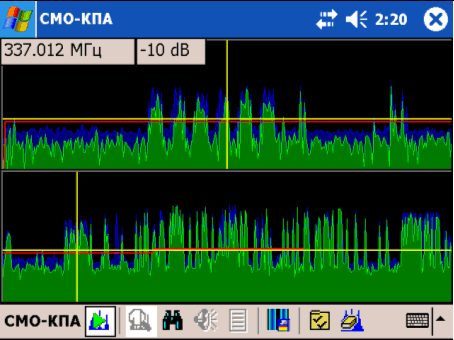
Fig. 1a. SMO-KPA: «Spectrum» mode
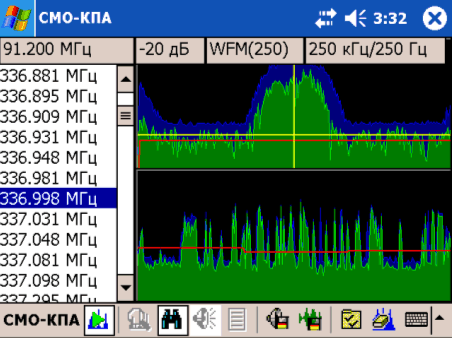
Fig. 1b. SMO-KPA: «Listening» mode
The main mode of the software package is the «Spectrum» mode (Fig. 1a), which provides panoramic spectral analysis in a frequency range that includes one or more non-overlapping sections.
During operation, the user has the ability to view on the PDA screen both a panorama of the radio signal spectrum in the entire analyzed range, and a detailed spectrum near the selected frequency, which allows the user to quickly assess the radio environment.
The program also has a «Listening» mode (Fig. 1b), which searches for active signals using various algorithms. The frequencies of detected radio signals can be saved in the PDA memory and subsequently called up for monitoring in manual or automatic modes.
The package allows you to listen to a demodulated signal with a given frequency and a selected demodulator, as well as view the signal spectrum at a given frequency with variable resolution.
Recording of the demodulated signal and the signal at an intermediate frequency in the PDA memory for subsequent analysis is provided.
It is also possible to record frequency-time data for subsequent deferred statistical processing on a stationary computer.
A report can be generated based on the results of the program's operation at the user's request.
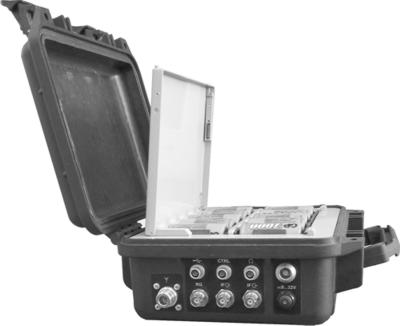
Photo 3. Panoramic measuring receiver «ARGAMAK-I»
The portable measuring complex for radio monitoring and direction finding ARK-NK3I is similar in design features and functions to the hand-held direction finder ARK-RP3.
It also includes a digital radio receiver and a set of directional antenna modules that provide amplitude direction finding in the frequency range from 300 kHz to 3 GHz.
The main difference is that this complex is built on the basis of the panoramic measuring receiver «ARGAMAK-I» (photo 3), certified by the State Standard of Russia [4].
The panoramic measuring receiver is available in various designs, including a protected version suitable for use in field conditions. Table 4 shows the main characteristics of the ARGAMAK-I receiver.
Table 4. Main technical characteristics of the panoramic measuring receiver «ARGAMAK-I»
| Range of operating frequencies | 25 — 3000 MHz |
| Frequency response flatness in the IF output passband | no more than ±1 dB |
| IF output passband | 2000 ± 4 kHz |
| Attenuation of mirror reception channels | no less than 70 dB |
| Attenuation of signals of frequencies equal to intermediate | no less than 70 dB |
| Frequency setting resolution in measurement mode | 1 Hz |
| Dynamic range for 3rd and 2nd order intermodulation in a 3 kHz passband | no less than 75 dB |
| Sensitivity (with a bandwidth of 3 kHz and a signal-to-noise ratio of 10 dB) in the operating frequency range | no more than 1 μV |
| Resolution for distinguishing two equal-level signals: | |
|
7 kHz |
|
7 kHz |
|
500 Hz |
|
200 Hz |
|
200 Hz |
|
100 Hz |
|
50 Hz |
|
30 Hz |
| Limit of permissible absolute error in measuring the level of a sinusoidal signal with calibration | ±1.5 dB |
| Limit of permissible absolute error in measuring the level of a sinusoidal signal without calibration | ±3 dB |
| Limit of permissible relative error in measuring the frequency of a sinusoidal signal (where Fi is the measurement frequency) | Fi 2 10-6 Hz |
| Power consumption, no more than | 35 VA |
| Supply voltage | 9 … 32 V |
| Ambient air temperature | +5 … +40° C |
| Relative humidity at 22° C | up to 80% |
| Atmospheric pressure | 84 … 107 kPa |
| Overall dimensions of the receiver in the case | 270x240x130 mm |
| Weight, no more | 5 kg |
Compared to the panoramic receiver «ARGAMAK», the panoramic measuring receiver «ARGAMAK-I» provides better frequency setting stability, as well as higher accuracy in signal level assessment.
Thus, unlike the hand-held direction finder ARK-RP3, the portable measuring complex ARK-NK3I's measuring functions come first — the ability to accurately measure electromagnetic field strength and radio signal parameters.
These functions in the basic configuration of the complex are provided by means of an industrial PDA and the SMO-KPAI program, which, having all the modes of the SMO-KPA program, has an additional “Measurement” mode, allowing measurements of radio signal parameters and electromagnetic field strength in accordance with the methods of the State Standard of Russia.
The measurement results are presented in the form of reports in the memory of the PDA and can then be copied to the memory of a stationary computer for subsequent analysis.
A portable measuring complex, controlled by an industrial PDA and the SMO-KPAI program, can be successfully used to monitor the use of the radio frequency spectrum and identify unlicensed transmitters.
Conclusion
Currently, protected pocket computers are included in the equipment of special forces units of many armies of the world. The protected pocket computer «Kulon» of domestic production is not inferior to its foreign analogues, and in a number of characteristics it even surpasses them.
The main area of application of protected pocket computers is the solution of navigation and control problems during the work of small mobile groups performing special tasks in field conditions. Nevertheless, a promising direction is the use of protected PDAs for the control of specialized portable equipment designed for use in field conditions. Examples of such equipment are the ARK-RP3 hand-held direction finder and the ARK-NK3I portable measuring complex for radio monitoring and direction finding.
The protected PDA «Kulon» and the panoramic analysis program SMO-KPA can significantly expand the basic capabilities of the hand-held direction finder ARK-RP3. The panoramic analysis and measurement program SMO-KPAI is an integral part of the portable measuring complex for radio monitoring and direction finding ARK-NK3I. Despite the fact that in a number of respects PDAs are inferior to tablet PCs and laptops, they have significantly better weight and size characteristics, can be used while the operator is moving and are indispensable in a number of applications.
REMBOVSKY Yuri Anatolyevich, Candidate of Physical and Mathematical Sciences
SOLOVYEV Igor Olegovich
Literature
- Hugh Jameson. The Soldier's Guiding Hand. Armada Issue 2, 2005, April/May, Feature Article (http://armada.ch/05-2/content.cfm).
- Rembovsky A.M., Ashikhmin A.V., Sergienko A.R. Portable automated radio monitoring equipment. /Special equipment, 2004, No. 4, pp. 39 – 47.
- Ashikhmin A.V., Kozmin V.A., Rembovsky Yu.A. Portable radio monitoring and radio emission source location system. /Special equipment, 2005, No. 2, pp. 27 35.
- Certificate of the State Standard of Russia on approval of the type of measuring instruments RU.E.35.018.A No. 18189 dated 04.07.2004, registered in the State Register of Measuring Instruments under No. 27325-04.

Добавить комментарий